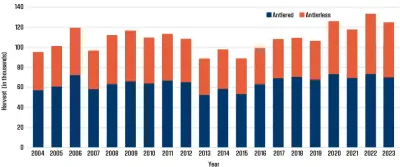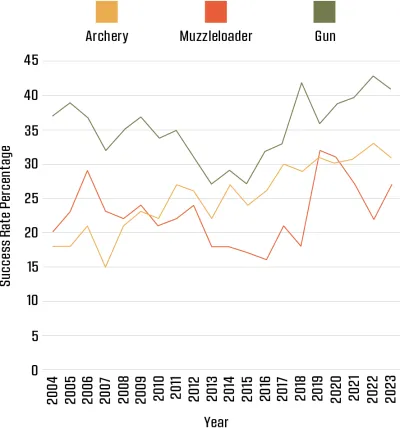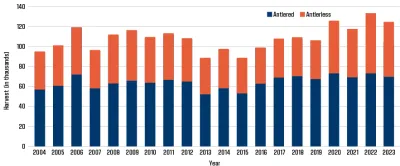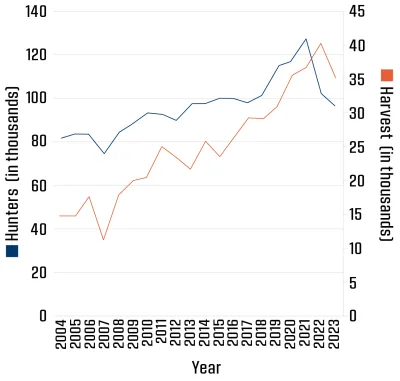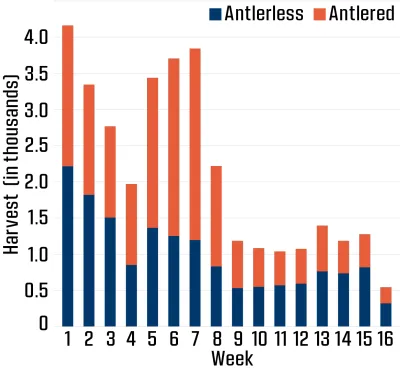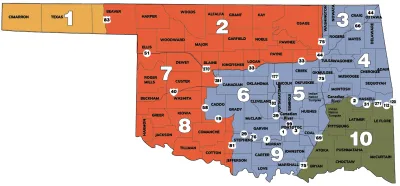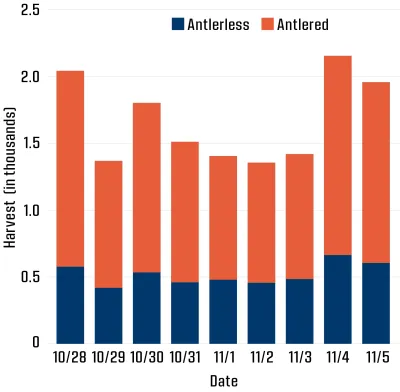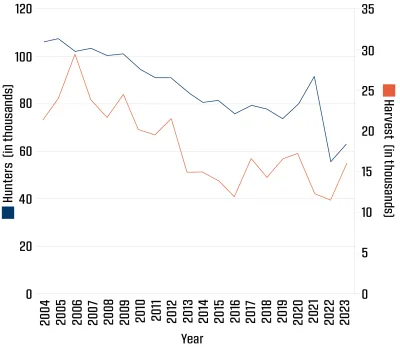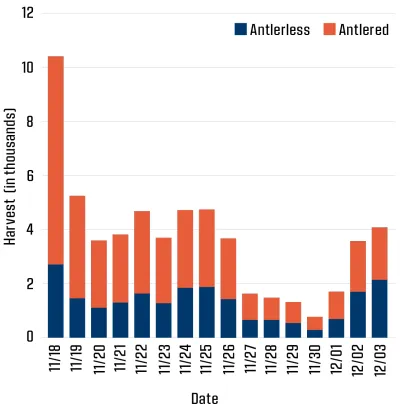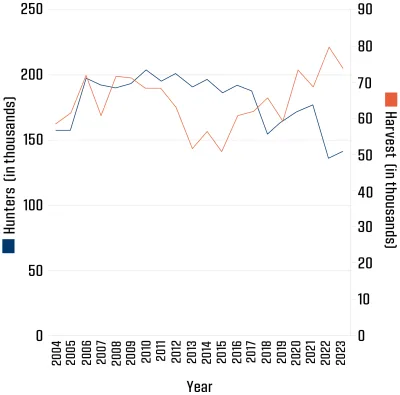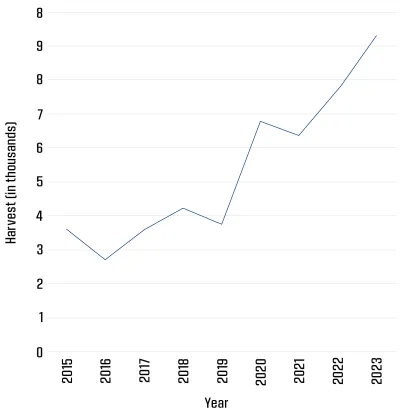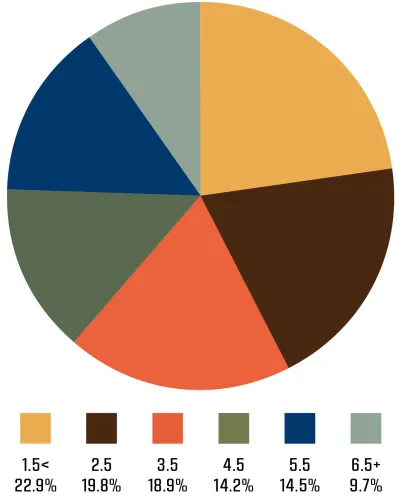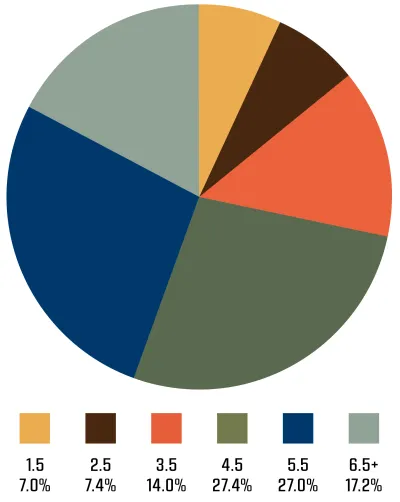STATE’S BIG GAME SEASONS ARE BIG WINS FOR HUNTERS
Record Black Bear Harvest Adds to Overall Success
By Dallas Barber, big game biologist, ODWC
Oklahoma’s 2023-24 big game seasons continued to ride the trend of great success for many of those participating in the various seasons for white-tailed deer, elk, pronghorn, and black bear.
Healthy habitat and healthy populations across much of the state resulted in a total reported harvest of 124,833 deer for all methods of take. While not a new harvest record, that total put Oklahoma’s seasonal deer harvest over the 120,000 mark for just the third time in the modern era.
Hunters continued to make management-minded decisions to benefit the state's deer population, with 44% of last year’s harvest being made up of antlerless deer. Figure 1 shows total deer harvest from 2004 to 2023-24.
Figure 1: Harvest Totals 2004-Current
Oklahoma's various gun seasons, including the 16-day modern firearms season, youth gun season, and holiday antlerless season, yielded 74,137 deer being harvested. Hunters choosing to participate in the nine-day muzzleloader season managed to tag 15,898 deer, while archery hunters managed to harvest 34,798 deer. Figure 2 shows success rates among those hunting methods. Figure 3 represents each individual method and their percentage of the total 2023-24 harvest.
Oklahoma is unique in its diversity of habitat. No other landlocked state comes close. From the swamps and pine mountains in the southeast to the short-grass and sage-filled prairies in the far northwest, Oklahoma has a hunting style for anyone who enjoys chasing deer in their free time. With that diversity in habitat comes varied diversity in populations and the availability of public property for those choosing to hunt in that county.
To represent that vast difference, Table 1 shows deer harvest by county with public lands such as wildlife management areas (WMAs) excluded. The top three counties by harvest are Osage County, with 4,379 deer harvested; Pittsburg County, 3,203; and Lincoln County, 2,798 deer.
Table 1: Harvest by County, Sex, and Method
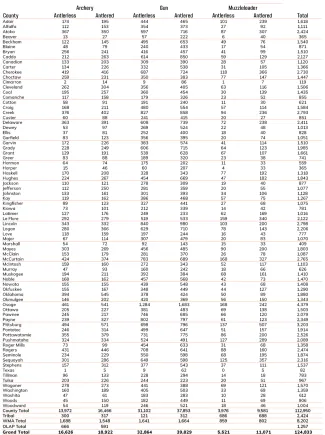
WMAs and other public lands managed by the Oklahoma Department of Wildlife Conservation make up for a small percentage of the total acreage in Oklahoma — about 3%. However, those public lands more-than pull their weight considering that 6.5% of the total deer harvest can be attributed to them. Details on those public land harvests can be seen in Table 2.
Table 2: WMA Harvest by Sex and Method
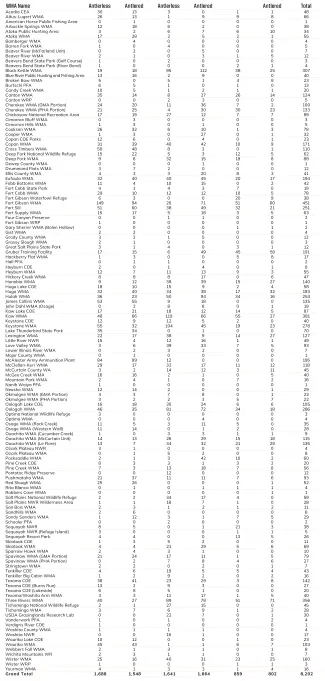
With the diversity in habitat comes diversity in species that live there. Oklahoma deer hunters heading “out west” are afforded an opportunity to harvest a mule deer. These populations are fragmented across the western one-third of the state and it can be a tough task to tag one. But hunters managed to harvest 242 Oklahoma mule deer during the 2023-24 season, a sizable increase from last season’s 209.
Such fluctuations in the mule deer population led ODWC to start a first-of-its-kind research project. Using collars, ODWC biologists along with university helpers are studying Oklahoma’s mule deer. There will be more to come on that research in the future. Details on mule deer harvest can be seen in Table 3.
Table 3: Mule Deer Harvest by County, Sex, and Method

DEER ARCHERY SEASON
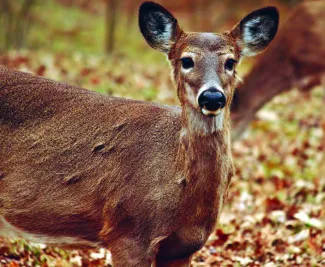
Archery hunters continue to find success in the field, with total reported harvest reaching 34,181 deer. While not a record-setting year like we’ve seen the past four years in a row, bowhunters continue to pull their weight when it comes to antlerless deer, which made up 46% of the total archery harvest.
The annual Game Harvest Survey (GHS), a scientific survey conducted by ODWC, has been tracking hunter participation metrics for decades. The GHS estimated that 95,384 hunters were afield at some point during the season with archery tackle in hand. This is lower than in years past, which included the tribal license compact that is no longer in effect. This will be the case with each methods hunter estimate numbers.
Archery season length remained unchanged, running uninterrupted from Oct. 1, 2023, to Jan. 15, 2024. The bag limit included a total of six deer, with no more than two of those being antlered. Figure 4 shows harvest and hunter trends over the years, while Figure 5 represents archery harvest by week.
Figure 4: Archery Hunters and Harvest 2004-Current
Figure 5: 2023-24 Archery Harvest by Week
DEER MUZZLELOADER SEASON
Oklahoma's nine-day muzzleloader season ran from Oct. 28 to Nov. 5 for the 2023-24 season. Bag limits remained unchanged, with hunters allowed four deer, only one of which could be antlered. Additional antlerless harvest has been encouraged through liberal antlerless bag limits in various antlerless zones, which are mapped out in Figure 11.
Figure 11: Deer Antlerless Zones
The GHS showed a large increase in both participation (62,899 hunters ) and harvest (15,898 ) compared to the previous year. Figure 6 shows muzzleloader season harvest by day. Figure 7 dives into harvest trends since 2004.
Figure 6: 2023 Muzzleloader Season Harvest by Day
Figure 7: Muzzleloader Hunters and Harvest 2004-Current
DEER GUN SEASON
A staple tradition in Oklahoma comes during the 16-day deer gun season, which ran from Nov. 18 through Dec. 3. Bag limits remained unchanged from years prior, with hunters allowed four deer with no more than one being antlered. Hunters bagged 74,137 deer in those 16 days, 36% of which were antlerless deer. Youth deer gun season accounted for an additional 3,490 deer, and holiday antlerless deer gun season added 9,305.
Figure 8 and Figure 9 break down gun harvest both by days of the season and trends over the years. Figure 10 shows holiday antlerless season harvest since 2015.
Figure 8: 2023 Gun Season Harvest by Day
Figure 9: Gun Hunters and Harvest 2004-Current
Figure 10: Holiday Antlerless Deer Gun Season 2015-Current
DEER AGE STRUCTURE
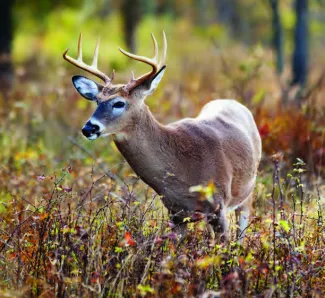
The ODWC works with multiple sources to obtain age data from our annual deer harvest. The data come from ODWC’s Deer Management Assistance Program (DMAP) cooperators, local meat processors, taxidermists, ODWC controlled hunts, and ODWC’s online Age My Deer program. The age data provide biologists with necessary information about the age structure and overall health of Oklahoma’s deer herds. Figure 12 and Figure 13 represent age at harvest for antlered and antlerless deer.
Figure 12: Doe Age at Harvest 2023-24
Figure 13: Buck Age at Harvest 2023-24
ELK SEASON
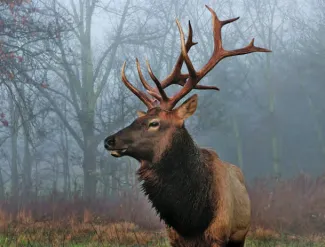
Oklahoma’s elk herds continue to enlarge and expand. While the most dense populations are still in relatively small pockets, elk continue to be taken in areas where large herds aren’t typically located. Hunting is allowed on private land with written landowner permission during statewide elk seasons, along with drawn hunts via ODWC’s controlled hunts program.
At the end of the season, 627 elk had been harvested across the state. A large majority of those came from the Special Southwest Zone of Kiowa, Comanche, and Caddo counties.
A breakdown of harvest by county, sex, and method is found in Table 4.
Table 4: Elk Harvest by County, Sex, and Method
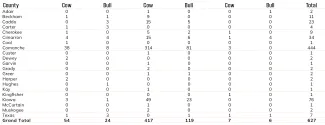
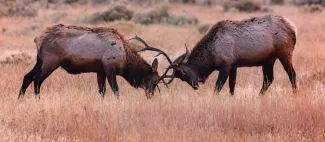
PRONGHORN SEASON
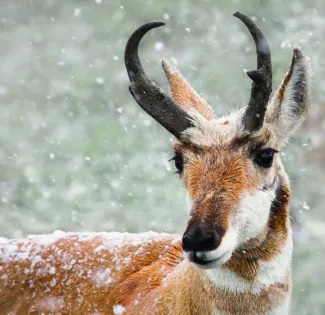
Yet another benefit of Oklahoma’s vast diversity in habitat is an opportunity to hunt North America’s fastest land animal: the pronghorn.
Oklahoma lies on the easternmost fringe of suitable habitat for these unique animals. With such a small and fragile population, hunting is limited to over-the-counter archery permits, controlled hunt drawings, and landowner-drawn permits. Total harvest for the 2023 season was 87. Table 5 provides a breakdown of harvest by county, method, and sex.
Table 5: Pronghorn Harvest by County, Method, and Sex

CHRONIC WASTING DISEASE UPDATE
The big game seasons of 2023-24 were the first that hunters had been afield since the discovery of chronic wasting disease (CWD) in Oklahoma’s native, wild herds. The always-fatal disease affecting cervids was discovered first in Texas County and shortly after in Woodward County.
Those who hunted in the far northwest portions of the state had some additional rules placed on the movement of carcasses after harvest to ensure no unnatural movement of highly infectious material was being done.
Hunters in those areas also had the opportunity to have their harvested deer tested for CWD by using one of five voluntary drop-off freezers within Selective Surveillance Areas (SSAs). Multiple hunters chose to have their deer tested, and all test results showed that CWD was not detected.
Rules and regulations pertaining to carcass movement will remain in place for the coming 2024-25 season, with testing drop-off sites being available for those who wish to have their harvested wild deer tested.
CONCLUSIONS
Sometimes when writing the Big Game Report each year, I feel like a broken record. Times are good. Oklahoma deer hunters continue to put into action the mindset of being deer managers. This can be seen in efforts to continue adequate antlerless harvest.
The 2023-24 season marks the fourth year in a row of meeting the antlerless harvest goal, that being 40% to 45% of total harvest. That level of antlerless deer harvest leads to healthier populations and all the good things that come with that.
Deer age at harvest continues to increase from seasons past. Hunters are truly adopting the “Hunters in the Know, Let Young Bucks Grow” motto. It's become a regular occurrence to see Oklahoma bucks gracing the cover of magazines such as North American Whitetail.
Considering that in the not-too-distant past, it was the talk of deer camp just to see a deer track, let alone a real live deer. Conditions now are better than ever. These are the glory days of Oklahoma deer hunting, and it’s all been accomplished via education instead of regulation.
There will continue to be challenges in the big game world. Urban expansion, disease, overpopulation, and a shrinking hunting community all will play roles in the future. If the past has taught me anything, it is that Oklahoma hunters will rise to the occasion and “grab the buck by the horns,” so to speak. I wish you the best of luck in your 2024-25 outdoor adventures. Take someone new. Pass the torch. And remember that every time you pull that trigger or release that arrow, you are making a management decision in the area where you hunt.
Good hunting.
BEAR HUNTERS TAKE STATE-RECORD 86 DURING 2023
By Matt Hensley Senior Wildlife Biologist
Black bear hunters had a record-setting season in 2023, taking 86 bears, which was 26 more than the year before and the highest recorded since Oklahoma’s first bear hunting season in 2009.
Archery hunters took 82 black bears, while muzzleloader hunters bagged four bears this past year. Oklahoma’s black bear hunting zone includes all or portions of 12 counties in southeastern Oklahoma.
Oklahoma’s previous record harvest for black bears was in 2018, when 85 bears were taken.
The 2023 season was the second time that Choctaw Nation authorities handled bear check-in for tribal members only. They checked 10 (all archery) of the 86 bears harvested. The average age of the bears harvested in 2023 was 4 years.
Hunters who took a black bear in Oklahoma last year hailed from eight states: Arkansas, Texas, Missouri, Kansas, Nebraska, Louisiana, Wyoming, and Oklahoma. This fact supports the assertion that Oklahoma is a true hunting destination for a variety of species.
Hunters should expect this fall’s bear seasons to be similar to last year’s, based on weather conditions so far this year.
However, hunters who hunt over bait may find it more challenging to compete with the mast crop of white oak acorns during the upcoming season. In 2023 the white oaks in some of the core harvest areas did not produce as well as they usually do. Consequently, many bears continued to visit hunter-bait sites more frequently, allowing for more harvest opportunities.
Hensley offers these tips for increasing your chances of taking a black bear:
- Locate an area with fresh bear sign and stay there; you might have to sit all day or hunt multiple days.
- Start hunting as early in the season as possible.
- Stay weather-aware. Cold and wet conditions make bears less active.
- If the weather is hot, consider hunting near a water source.
- Bears will return to whatever food source is helping them gain the most weight. Acorns, especially from white oaks, are preferred by bears in non-bait areas.
- Start scouting for hunting spots in September.
All hunters wanting to pursue a black bear must buy either an archery or muzzleloader bear license before the opening dates of each season. Archery bear season dates are defined in statute, running from Oct. 1 until the third Sunday in October. In 2024, archery bear season will close on Oct. 20. Archery bear season has no harvest quota.
Muzzleloader bear season will be Oct. 26-Nov. 3, but the season will close as soon as a quota of 20 bears has been reached. Before they hunt, muzzleloader hunters must call for the latest bear quota information at 888-901-3256.
For details on black bear hunting, consult the Oklahoma Fishing and Hunting Regulations online, in the Go Outdoors Oklahoma mobile app for Apple and Android, or in the printed version free at license dealers statewide.
